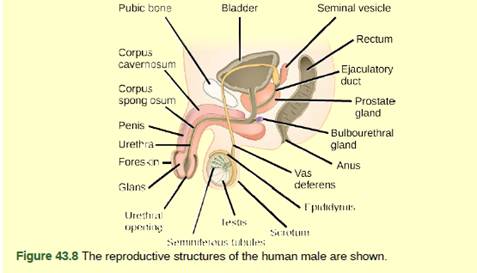
Figure 43.8 Which of the following statements about the male reproductive system is false?
- The vas deferens carries sperm from the testes to the penis.

Introduction:
The male reproductive system comprises a number of sex organs, which plays a function in the procedure of human reproduction. The male organs are present exterior to the body indside the pelvis. The main sex organs are the testicles and the penis, which generate sperm and semen, that is, as a part of sexual intercourse, fertilize an ovum in the body of a female.
Answer to Problem 1VCQ
Correct answer:
The correct answer is option (d) the prostate gland is located in the testes.
Explanation of Solution
Explanation/justification for the correct answer:
Option (d) the prostate gland is located in the testes. The prostate gland is not located inside the testes. It is one of the male accessory glands that are situated between the penis and the urinary bladder. This gland generated fluid that nourishes as well as safeguards semen. So, the correct answer is option (d).
Explanation for the incorrect answer:
Option (a) the vas deferens carries sperm from the testes to the penis. The sperms are generated in the male gonads, that is, the testes. From the site of generation, they are conducted through the vas deferens towards the seminal vesicles that supplements its own discharging to the oncoming sperms. Then the semen is transmitted towards the penis via an ejaculatory duct that unites with the urinary duct to produce a common duct. So, this is an incorrect option.
Option (b) sperm mature in seminiferous tubules in the testes. The maturation of sperm takes place in the seminiferous tubules. These tubules are situated in the testes. So, this is an incorrect option.
Option (c) both the prostate and bulbourethral glands produce components of the semen. The prostate gland generates a milky fluid that produces the semen with viscosity. While the bulbourethral gland supplements a neutralizing fluid in the semen. So, this is an incorrect option.
The statement, that is, the prostate gland is situated in the testes is false. Hence, the false statement is option (d) the prostate gland is located in the testes.
Want to see more full solutions like this?
Chapter 43 Solutions
Biology 2e
Additional Science Textbook Solutions
College Physics: A Strategic Approach (3rd Edition)
Genetic Analysis: An Integrated Approach (3rd Edition)
Applications and Investigations in Earth Science (9th Edition)
Biology: Life on Earth (11th Edition)
Microbiology: An Introduction
Human Anatomy & Physiology (2nd Edition)
- How is a protein destined for the Endoplasmic Reticulum (ER), imported into the ER? Be concise.arrow_forwardFind out about the organisations and the movements aimed at the conservation of our natural resources. Eg Chipko movement and Greenpeace. Make a project report on such an organisation.arrow_forwardWhat are biofertilizers and mention the significancearrow_forward
- PCBs and River Otters: Otters in Washington State’s Green-Duwamish River have high levels of polychlorinated biphenyls (PCBs) in their livers. PCBs can bind to the estrogen receptors in animals and disrupt the endocrine system of these otters. The PCBs seem to increase the estrogen to androgen ratio, skewing the ratio toward too much estrogen. How would increased estrogen affect the river otter population? Based on your reading of the materials in this unit, what factors can affect fertility in humans? Explain how each of the factors affecting human fertility that you described can disrupt the human endocrine system to affect reproduction.arrow_forwardOther than oil and alcohol, are there other liquids you could compare to water (that are liquid at room temperature)? How is water unique compared to these other liquids? What follow-up experiment would you like to do, and how would you relate it to your life?arrow_forwardSelection of Traits What adaptations do scavengers have for locating and feeding on prey? What adaptations do predators have for capturing and consuming prey?arrow_forward
- Competition Between Species What natural processes limit populations from growing too large? What are some resources organisms can compete over in their natural habitat?arrow_forwardSpecies Interactions Explain how predators, prey and scavengers interact. Explain whether predators and scavengers are necessary or beneficial for an ecosystem.arrow_forwardmagine that you are conducting research on fruit type and seed dispersal. You submitted a paper to a peer-reviewed journal that addresses the factors that impact fruit type and seed dispersal mechanisms in plants of Central America. The editor of the journal communicates that your paper may be published if you make ‘minor revisions’ to the document. Describe two characteristics that you would expect in seeds that are dispersed by the wind. Contrast this with what you would expect for seeds that are gathered, buried or eaten by animals, and explain why they are different. (Editor’s note: Providing this information in your discussion will help readers to consider the significance of the research).arrow_forward
 Biology 2eBiologyISBN:9781947172517Author:Matthew Douglas, Jung Choi, Mary Ann ClarkPublisher:OpenStax
Biology 2eBiologyISBN:9781947172517Author:Matthew Douglas, Jung Choi, Mary Ann ClarkPublisher:OpenStax Concepts of BiologyBiologyISBN:9781938168116Author:Samantha Fowler, Rebecca Roush, James WisePublisher:OpenStax College
Concepts of BiologyBiologyISBN:9781938168116Author:Samantha Fowler, Rebecca Roush, James WisePublisher:OpenStax College Human Biology (MindTap Course List)BiologyISBN:9781305112100Author:Cecie Starr, Beverly McMillanPublisher:Cengage Learning
Human Biology (MindTap Course List)BiologyISBN:9781305112100Author:Cecie Starr, Beverly McMillanPublisher:Cengage Learning Human Physiology: From Cells to Systems (MindTap ...BiologyISBN:9781285866932Author:Lauralee SherwoodPublisher:Cengage Learning
Human Physiology: From Cells to Systems (MindTap ...BiologyISBN:9781285866932Author:Lauralee SherwoodPublisher:Cengage Learning





